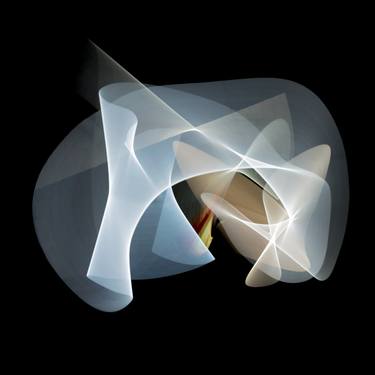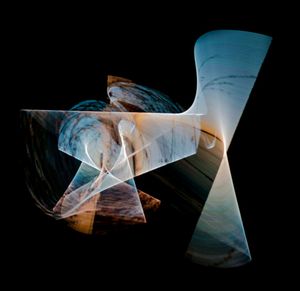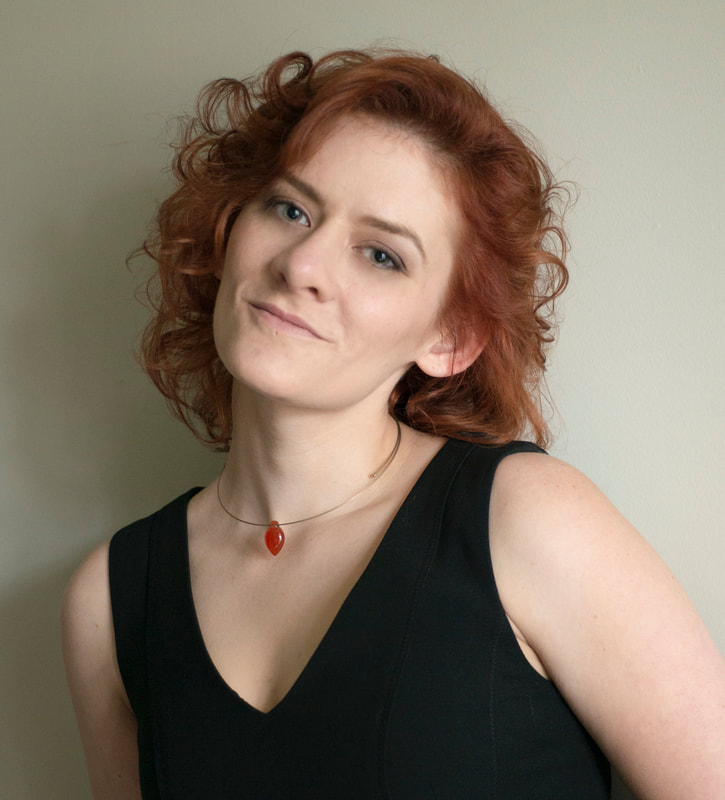Inspired by ‘Ōlelo No‘eau E ala! E alu! E kuilima! (Up! Together! Join hands!), Hepner imagined a fun, collaborative event where people from the community can move, dance and join hands together to make light-painted portraits of each other - noting that if social distancing (still) needs to be taken into consideration (which it does!), these workshops could be held outdoors, in a shaded spot during daylight hours with community members asked to hold out hands to each other, but staying separate, with hands brought together digitally by the artist.
Now just 2 weeks out from her Wailuku residency, the Pittsburgh-based new media artist slash professor of Integrative Arts at Penn State University’s Greater Allegheny campus shares some thoughts regarding her ST*BA journey to date, her hopes for her Wailuku residency and finding balance during this time of social distancing.
ST*BA: What ST*BA projects have resonated with you from your vantage point thousands of miles away, if any?
Hepner: The lost & found projection piece is something that would have been awesome to see on the night that it was projected! As a new media artist, I love when light-based projects get to be presented in unexpected locations in communities. It’s a way to really surprise and delight the people who live nearby.
Also, aesthetically, I just really like the way the Native Protector mural was designed with a mix of interesting details in the coral with other areas being much more about color and geographic shapes.
ST*BA: What was the process of selecting an ‘Ōlelo No‘eau like for you?
Hepner: I selected, “E ala! E alu! E kuilima! Up! Together! Join hands!” for the project after reading through much of the book of proverbs. Coming together with the community to join hands to meet and make artwork in a fun and joyous way is at the heart of my project, even as it is a bit non-traditional from a public-art standpoint.
I found reading through the proverbs to be insightful on the mindset of Hawaiian culture and am looking forward to listening to the stories from the community during my project so that I can help to make art that reflects the values of the people living in Wailuku.
ST*BA: Why did you apply for ST*BA
Hepner: I was really impressed by how ST*BA has worked with bringing the community into all of their past projects. Sometimes the community engagement is something that a public art project will claim to have, but in actuality, is only a minimal part of it. As I’ve been transitioning to do more public art projects over the past few years, from primarily making work to exhibit in galleries and museums, I’ve most enjoyed the projects where I get to have a real connection to the people in a community. That type of connection allows for the art that gets made to be much richer and meaningful for those who have been a part of making it happen.
The community connection was so obvious from ST*BA’s call for artists and website that it felt like a place where a public art project would be a true collaboration between the community and the artists it works with. I also knew that there was a true commitment to the arts because the National Endowment for the Arts only gives out their Our Town grants to organizations and projects that have both top notch art and community engagement. My summer 2021 project, Alloy Pittsburgh 2021, organized by Rivers of Steel Arts was also funded by an NEA Our Town grant, although it was supposed to happen in 2020, but was delayed due to COVID-19 to 2021.
ST*BA: What would be the best case scenario for your time with us in Wailuku?
Hepner: Well, I am hoping to be able to collaborate with as many people as possible to create light-paintings and portraits of each other from the community that I will be using to make some art from. The current effects of COVID-19 and whatever level the restrictions on gathering will be set at will be the defining factor on how many people from the community get to participate in person.
I know that I will be working with some of the students at ʻĪao Intermediate School to create light-paintings using my wearable LED lights and 6’ tall LED stick that I am able to program with photographs on my first days in Wailuku. Ideally, this will lead to setting up my computer, projector, and screen to do some outdoor light-painting with community members on Saturday 10/2/21. I hope that we are able to capture silhouette portraits of Wailuku as well as more abstract designs from joyful dancing and movement while people are wearing the LEDs.
I’ll then be spending time on my laptop outside in Wailuku creating artwork, as both printed murals that will be installed along Market Street outdoors and video pieces will be projected at night using the light-painting video material from the community art making. The whole point of me setting up with my laptop in public is to have interactions with people as they go about their days, much like someone might stop to talk to a mural artist working outdoors on a painting. I might even be able to make impromptu silhouette portraits of people as they come by, if my laptop spot allows for that to happen. There will be some kind of sign making it clear that I want people to stop and talk with me!
ST*BA: What have been some of the takeaways from a past experience you've had as a visiting artist?
Hepner: Everyday people, who don’t consider themselves artists, are much more creative than they give themselves credit for! There is always a moment where someone I’m working with in a light-painting session will do something with my technology that I never even thought of! I love when this happens! It is really how I best connect with people and community centered projects; by allowing those moments to happen.
ST*BA: Where do you teach/ How long have you taught for/ what do you love about teaching?
Hepner: I’ve been teaching photography and digital art & design courses for the past 14 years at Penn State University. More recently, I’ve been teaching a new art/science integrative studies course where students get to look at the natural world from both disciplines. My campus, Greater Allegheny, has a digital literacy program where each student gets an iPad to use, which makes teaching digital art much easier because I know that everyone has equal access to technology. This lets us go outside to a neighboring park and digitally draw from nature while also using apps that can identify plant species through photo uploads. This course has been great because it has allowed me to collaborate and take part in making art with my students, which led me to start collaborating with communities in public art projects, much like I’ll be doing in Wailuku.
I love being able to see creativity spark in students who never considered themselves to be artists and to see their progress over the course of a semester, or even multiple semesters. I have a policy that there is no such thing as a stupid question, especially when it comes to technology. Not all the students come from backgrounds where technology is available to them at home, so I make it a point to walk them through all of the steps on our projects.
ST*BA: How do you find balance between teaching and creating art?
Hepner: I am lucky to have a position where making art is considered part of my official responsibilities for the university as “research/creative activity,” so this gives me some time each week when I can work on art projects. There are certain times during a semester when I must focus more on teaching, like when projects have just been turned in and I have a mountain of grading to finish. It balances out with more time for artmaking when it is the summer and I don’t have classes, or if it’s the once-in-7-years timing when I am able to apply for a sabbatical from teaching to focus on art. That is one big reason why I’m able to come to Wailuku for this project, as it would be difficult for me to travel so far away when it is only a few weeks into the semester, in any other semester.
ST*BA: How would you briefly describe your Pittsburgh neighborhood, perhaps to someone from Wailuku who has never been to that part of the world?
Hepner: Pittsburgh was very prominent during the industrial revolution as the steel making capital of the world. In the 80’s most of the mills closed and over 300,000 people lost their jobs and left the city. It wasn’t a great time for the area. I am an 80’s child myself and grew up in a blue collar Pittsburgh neighborhood, so I saw this happening as a kid, but didn’t really understand the larger context of it. Since then, the region has pivoted to medicine, education, and technology, with many of the self-driving car companies moving here. But there are still a few active steel mills, which unfortunately brings air pollution levels higher than anyone would like.
I live in a city neighborhood in Brighton Heights, which is in the Northside area of the city. It’s a neighborhood of houses with backyards, some trees in the sidewalks, with its own little two block business district with small coffee, pizza, gym, and cell-phone shops. We have the last little meat-market in the city, which was used as a set for a Netflix shoot. (for a not yet released show, Archive 81) this past winter.
The city is largely defined geographically by the delta of two rivers, coming together to make a third, the Ohio, that makes its way into the Mississippi. They carved out many of the rolling hills that are now covered with trees and houses. In the summer, I like being able to go 10 minutes from my house, just next to the Andy Warhol Museum and rent a kayak to row around the river with our downtown and the stadiums in view. We have the most bridges in the world, beating out Venice, Italy and more than one of the steepest streets in the world; here, sets of steps are considered public streets. That caused a lot of driving problems when Google Maps first started! You can’t drive down a set of city steps, even if they have a street name!
ST*BA: What are you most looking forward to in your ST*BA experience?
Hepner: I am really looking forward to hanging out on Market Street in Wailuku, making art on my laptop outside, drinking coffee, and meeting people who come by. I’ve spent much time alone over the past 18 months, even as I’ve taught and met with people via Zoom, and I miss being able to talk to people about art and to make art with others. I can’t wait to see what makes Wailuku special and incorporating important aspects of the community and its spirit into the artwork that will luckily be able to be there after I return home.
|
Stay up to date with project developments, community consultations, photos and more on Lori Hepner’s ST*BA project page (https://www.smalltownbig.org/hepner.html) as well as our Instagram (https://www.instagram.com/smalltownbigart/), Facebook (https://www.facebook.com/smalltownbigart) and Vimeo (https://vimeo.com/smalltownbigart) platforms. Know a Wailuku community member who should be involved? Contact us. |




 RSS Feed
RSS Feed